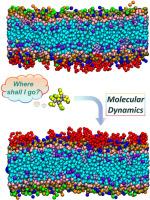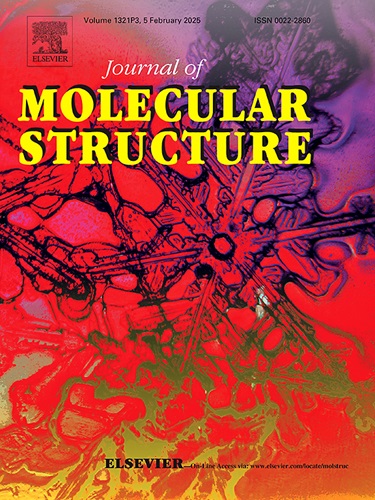GM1在细胞膜上吸附聚精氨酸及其团聚形成的机理:粗粒度分子动力学研究
IF 4.7
2区 化学
Q2 CHEMISTRY, PHYSICAL
引用次数: 0
摘要
神经节苷脂 GM1 是神经元细胞中的一种重要糖脂,在病原体识别、信号转导和蛋白质分选等各种生物过程中发挥着重要作用。聚精氨酸被广泛用作设计细胞穿透肽的模板,在分子货物运输和信息传递方面具有极高的价值。研究聚精氨酸与含 GM1 细胞膜的相互作用机制和物理化学原理,对于了解特定细胞成分的功能和开发新型药物至关重要。在这项研究中,我们采用粗粒度分子动力学模拟来探索不同浓度和聚合度的聚精氨酸与人脑神经元细胞膜模型之间的相互作用过程。我们的研究结果表明,多精氨酸主要在静电相互作用的驱动下优先吸附在 GM1 上,并在膜上聚合成团,这有助于膜的稳定。此外,聚精氨酸对 GM1 浓度升高的膜具有更高的亲和力,这突显了它在靶向特定膜成分方面的潜力。这些见解对于利用高性能计算模拟方法设计分子靶标和理解脂质组学中的生物物理机制至关重要。本文章由计算机程序翻译,如有差异,请以英文原文为准。

Mechanics of poly-arginine adsorption onto cell membrane by GM1 and their cluster forming: Coarse-grained molecular dynamics study
Ganglioside GM1 is a crucial glycolipid in neuronal cells, playing significant roles in various biological processes such as pathogen recognition, signal transduction, and protein sorting. Poly-arginine, widely used as a template for cell-penetrating peptides design, is highly valuable for molecular cargo delivery and information transmission. Investigating the interaction mechanisms and physicochemical principles of poly-arginine with GM1-containing cell membranes is essential for understanding the functions of specific cellular components and for developing novel drugs. In this study, we employed coarse-grained molecular dynamics simulations to explore the interaction processes between poly-arginine of varying concentrations and polymerization degrees with model membranes of human brain neuronal cells. Our findings reveal that poly-arginines preferentially adsorb onto GM1 and aggregate into clusters on the membrane, primarily driven by electrostatic interactions, which contributes to membrane stabilization. Additionally, poly-arginine shows a higher affinity for membranes with elevated GM1 concentrations, highlighting its potential for targeting specific membrane compositions. These insights are crucial for designing molecular targets and understanding the biophysical mechanisms in lipidomics using high-performance computational simulation methods.
求助全文
通过发布文献求助,成功后即可免费获取论文全文。
去求助
来源期刊

Journal of Molecular Structure
化学-物理化学
CiteScore
7.10
自引率
15.80%
发文量
2384
审稿时长
45 days
期刊介绍:
The Journal of Molecular Structure is dedicated to the publication of full-length articles and review papers, providing important new structural information on all types of chemical species including:
• Stable and unstable molecules in all types of environments (vapour, molecular beam, liquid, solution, liquid crystal, solid state, matrix-isolated, surface-absorbed etc.)
• Chemical intermediates
• Molecules in excited states
• Biological molecules
• Polymers.
The methods used may include any combination of spectroscopic and non-spectroscopic techniques, for example:
• Infrared spectroscopy (mid, far, near)
• Raman spectroscopy and non-linear Raman methods (CARS, etc.)
• Electronic absorption spectroscopy
• Optical rotatory dispersion and circular dichroism
• Fluorescence and phosphorescence techniques
• Electron spectroscopies (PES, XPS), EXAFS, etc.
• Microwave spectroscopy
• Electron diffraction
• NMR and ESR spectroscopies
• Mössbauer spectroscopy
• X-ray crystallography
• Charge Density Analyses
• Computational Studies (supplementing experimental methods)
We encourage publications combining theoretical and experimental approaches. The structural insights gained by the studies should be correlated with the properties, activity and/ or reactivity of the molecule under investigation and the relevance of this molecule and its implications should be discussed.
 求助内容:
求助内容: 应助结果提醒方式:
应助结果提醒方式:


